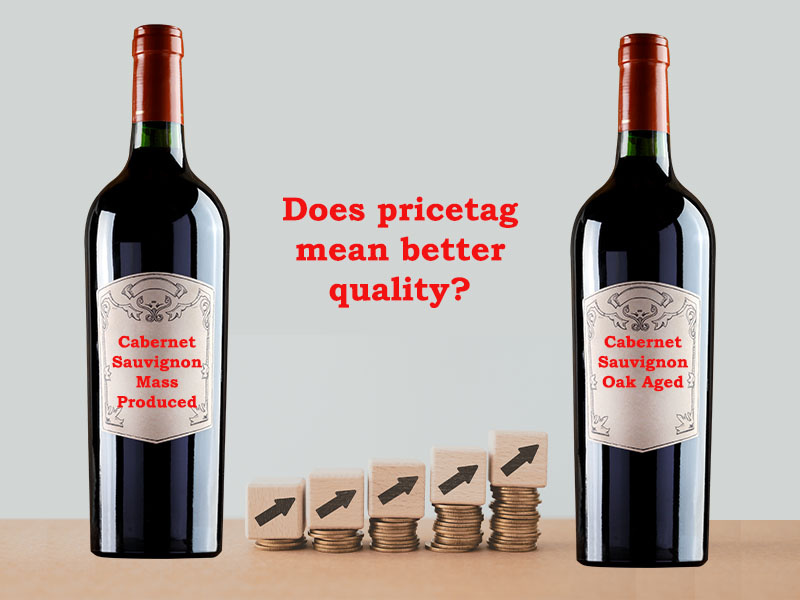Trick or Treat? Inexpensive vs. Expensive Wines
- Posted on
- Posted in Cabernet Sauvignon, California, French
- 0

Can you pick out the cheap
There are three major traits to consider in “expensive” wine: oak, time, and terroir. Oak—Some of the best wineries in the world use oak, and many use new oak. Putting wine in barrels adds oak “flavors” to a wine (such as vanilla and baking spice), and it exposes the wine to oxygen. Oxygen does some really great stuff to wine: the tannins become less intense, and the taste of the wine becomes smoother. Oak barrels are expensive. Only 2 barrels can be made from a mature oak tree. French barrels are in demand, so they cost about twice as much as American barrels.
Holding wines to age takes up space and costs, reducing space for new inventory, and holding wine back means a lag time in the sale of that wine. Space for storing barrels becomes a premium, thus requiring a larger facility or use of space at another vineyard, which comes with extra cost. Time—“The older the better.” This is the assumption when it comes to wine; however, this mainly pertains to red wine. Time changes the taste of the fruit flavors in a wine, as well as it reduces the acidity and tannin in a wine.
Terroir—What is grown in the vineyard and where also matters. For instance, in Napa during the 2010 vintage, the price of decent Merlot fruit per ton was about a third of the price the Cabernet Franc. The price added to the bottle of Cab Sauv was double in comparison to a bottle of Merlot. As the terroir becomes more specific and scarcer, the price usually jumps up. For instance, if you buy a generic “California” wine, it might cost $12 compared to an appellation-specific wine, like “Sonoma,” or “Napa.” Some regions are so small and in demand that the price becomes exponential—think small-lot wineries in Italy and Burgundy.
Smaller lots mean less grapes = less wine. Every great winemaker will tell you that great wine is made in the vineyard. Great wine takes great grapes. Wineries that focus on reducing yields—minimizing the fruit produced—do so, so that resulting fruit/wines are fuller of flavor/intensity. The location of where the grapes are grown also matters. It’s been noted that the best vineyards tend to be in an area where the vines struggle to produce grapes. For example, good grapes tend to grow on a hill with low-nutrient soils, versus in fertile soils on flat lands closer to a river.
Things to consider about those lesser-priced/“Budget-friendly” wines are that they are more often mass-produced, are often a blend of several vintages (or NV “non-vintage”), several grapes, and several regions (e.g., “California” or “USA” on the label). These are hodge-podge wines, usually cost less than $10 a bottle and come with an after-effect of a headache. Residual sugar may be used to improve the flavor which is usually lacking in many fine wines. Sulfates and other stabilizing additives are usually also used in generous portions to make the wine “consistent” each year. During winemaking, yeast typically converts all the sugar into alcohol, making a dry wine. However, in some cases not all the sugar is fermented by the yeast, leaving some sweetness leftover. Taste can often quantify quality as a sense of “richness” or “body” in wine. Since richness in wine can be achieved with sweetness (which you can’t easily detect), this could be why cheap wines performed equally, if not slightly better, than expensive wines in the study. Cheaper wines mean projected sales drive production; small production is not possible, less or no time in oak, machine-harvested grapes from a generalized region (e.g. “California”), blend of wine grapes, and often contain residual sugar to add perceived richness .
These are just a guide to consider. Not all “inexpensive” wines are “bad,” and not all “expensive” wines are “good!” Try your favorite varietal from a different region; for example, try a Chardonnay or a Cabernet from Chile, or a Pinot Noir from New Zealand. Wines from lesser-known wine regions are often lesser-priced, due to market value. Save your money on your everyday wines and use that budget for the wines made with more care and not mass-produced. A lot of wines do follow the rule of “you get what you pay for.” Do a blind tasting with your friends this Halloween and see who can pick out the “cheap” wine from the pricier one.
Have fun and remember, life is too short to drink bad wine!

Comments
Be the first to comment...